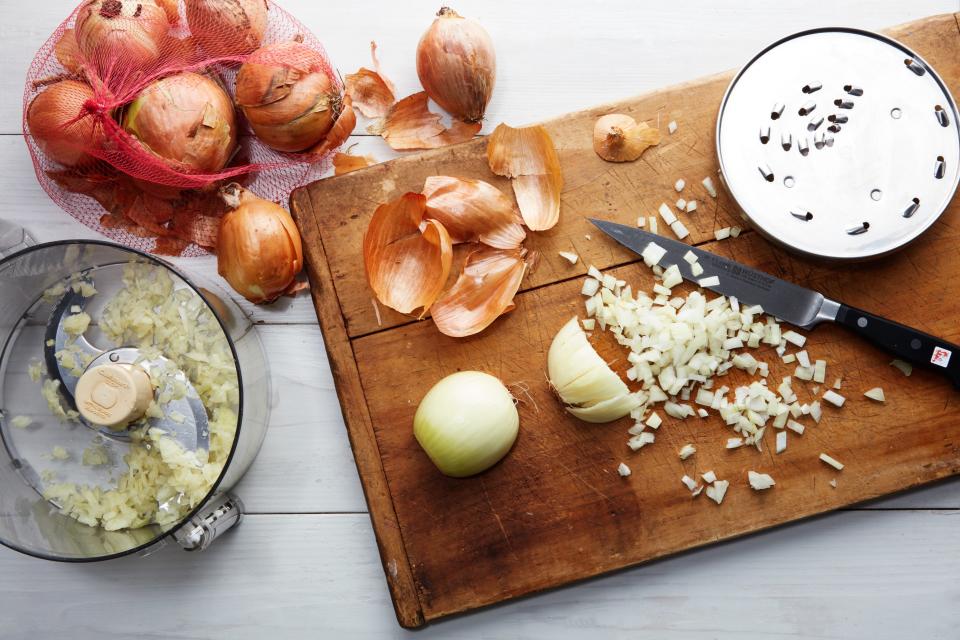My Dad (the Chef) Told Me Not to Bother With Food Processors—But He Was Wrong
My hummus was chunky. Not in a charmingly textured sort of way. In a more-like-mushy-chickpeas-than-hummus sort of way. I could tell that the NutriBullet I was using was, first of all, too small, and, second, completely sealed at the top, which kept me from slowly streaming in olive oil as I pulsed through the chickpeas. I wanted a swirling vortex that pulled in any unblended pieces, but I had oily soup beneath the blades and entirely untouched legumes above. It took several rounds of stopping and scraping, but I finally reached something hummus-adjacent. Still, I knew there had to be a better way.
Like most city apartment dwellers, my kitchen is small. I try to limit my appliances to a small, space-saving blender and a toaster. In my house, whipped cream comes together by good ol’ wrist strength, as does cookie dough. But increasingly, it seemed like there was one appliance I couldn’t replace with my own willpower and brute force: a food processor.
As I often do when I have a kitchen question, I texted my dad, a chef and restaurateur, to ask which brand of food processor he had at home so I could get a similar one.
“I don’t have one,” he responded.
“But what if you need to make hummus? Or breadcrumbs? Or turn sugar into superfine sugar???” I typed.
“I don’t,” he texted back.
Upon further interrogation, his stance became slightly more clear: if a recipe calls for the fine chopping of a food processor, he’ll either do it by hand or make something else.
And that was that.
Or so I thought, until a package arrived at my apartment a few days later, containing an immersion blender and a note stating it was from my dad. A food processor, it seemed, was unnecessary, but he felt than an immersion blender deserved a spot in my tiny kitchen arsenal.
Back in the office, I asked senior food editor Anna Stockwell if she felt that my new tool could solve all of my food-processing problems.

Chopping onions with a food processor- HERO
“I love using my food processor for cutting butter into pie dough,” she said. “Really, making any dough is easier in a food processor.” That's definitely something an immersion blender can’t do, since blenders perform best when there’s a lot of liquid involved. Since the processor's blades are super-sharp, they can easily slice through onions, or grind through nuts and seeds to make almond or sunflower butter. And special disks on the processor make shredding potatoes and carrots a snap. Finally, Anna said that she prefers making hummus (!) in her food processor because you can leave it running and go about your business, unlike an immersion blender that you’ll need to hold onto.
I wanted to put my immersion blender to the test, but the obvious first use was a pot of creamy soup, and it was still too hot in my kitchen to even think about roasting squash. Inspiration struck in the bulk bins of Whole Foods: I scored some pine nuts and tried my hand at pesto.
The immersion blender...sort of worked. At first I had a paste of pine nuts stuck beneath the cupped blade and the blender struggled to incorporate the basil and parmesan. I added olive oil until the sauce reached a consistency the blades could churn through better and, eventually, my handfuls of basil became a sauce I could toss into linguine. Would a food processor have worked better? Probably. I quickly realized though that the immersion blender takes almost no time to clean, and, once I finally took it out of the box, requires very little drawer space to store.
Perhaps the most unanticipated side effect of the immersion blender is that it has given me the ability to see my future. My fall and winter will be full of aioli, homemade salad dressing, and freshly made soups, but—for now at least—no hummus.
Originally Appeared on Epicurious

